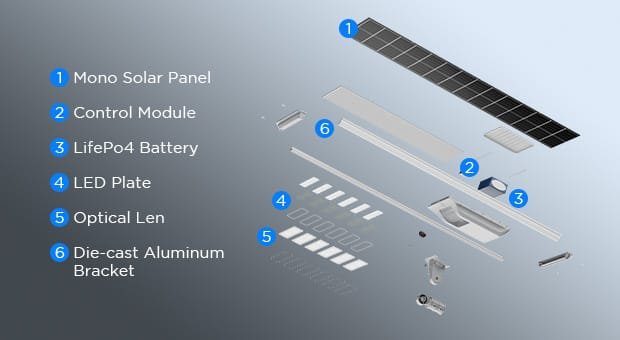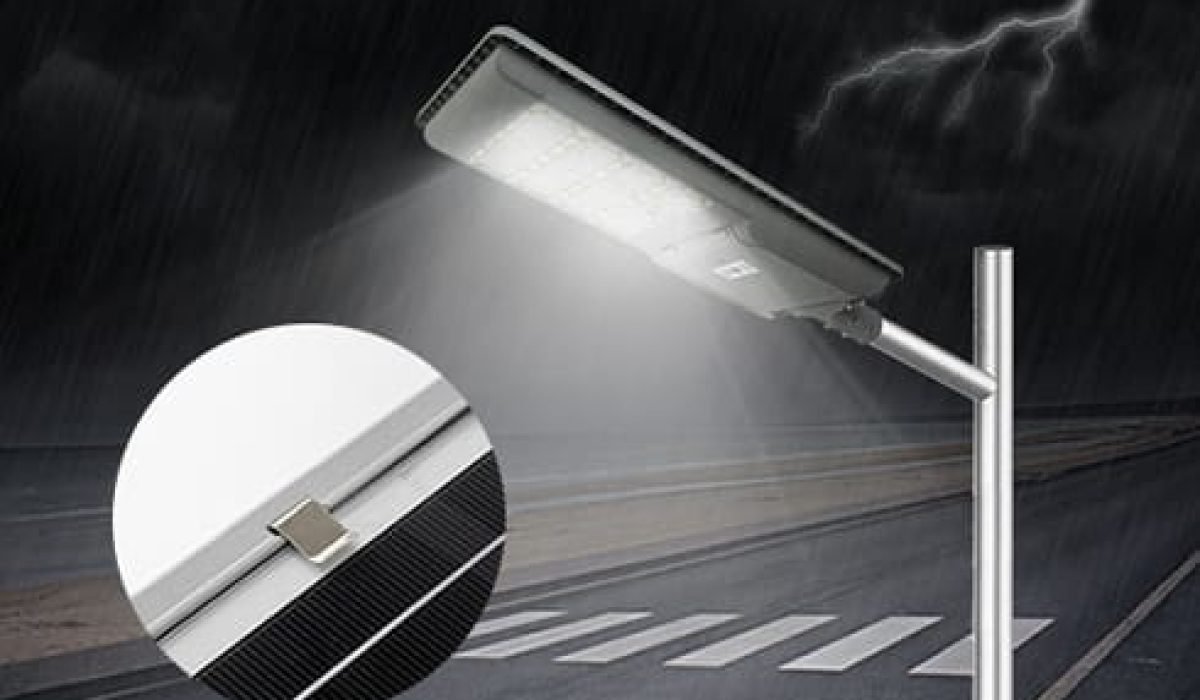All-in-one solar lights are booming—but why do two similar-looking lights cost $150 and $600?
The price of all-in-one solar lights depends on components like battery, panel, materials, smart features, and brand support.
This article breaks down the real cost factors so you can buy smarter—not just cheaper.
What Are All-in-One Solar Lights and Why Cost Varies?
These lights combine a solar panel, LED lamp, battery, and controller into one integrated unit.
All-in-one solar lights are compact, easy to install, and designed for fast deployment—but pricing depends heavily on what’s inside.
Cost Breakdown Factors
- LED wattage and light output
- Battery type and size
- Solar panel efficiency
- Smart features and sensors
- Casing material and weatherproofing
- Brand, warranty, and certifications
Even small spec changes can double or triple total cost.
Key Factors That Affect the Cost of All-in-One Solar Lights

Let’s break down the six most important cost drivers from an engineering and procurement perspective.
2.1 Wattage and Brightness (Lumens)
More watts = more LEDs = more heat = higher cost.
| Wattage | Typical Lumens | Application | Price Range |
|---|---|---|---|
| 20W | ~2,000 lm | Pathways, gardens | $100–$200 |
| 40–60W | ~4,000–7,000 lm | Rural roads, yards | $250–$450 |
| 80–100W | ~8,000–12,000 lm | Parking lots, public roads | $500–$1,000 |
High-brightness systems also need better heat sinks and drivers—adding cost.
2.2 Battery Type and Capacity
Battery quality shapes performance and cost.
| Battery Type | Lifespan | Charging Cycles | Cost Level |
|---|---|---|---|
| Lead-acid | 1.5–2 years | 300–500 | Low |
| Lithium-ion | 3–5 years | 1,000–1,800 | Medium |
| LiFePO₄ | 5–8 years | 2,000–3,000 | High |
Bigger batteries (in Wh or Ah) add reliability but increase price. Always check battery specs, not just wattage.
2.3 Solar Panel Size and Efficiency
The panel determines charging speed and system autonomy.
| Type | Efficiency | Lifespan | Price Impact |
|---|---|---|---|
| Polycrystalline | 15–17% | 20–25 years | Lower |
| Monocrystalline | 18–22% | 25+ years | Higher |
Higher-efficiency panels need less space, ideal for compact designs—but cost more per watt.
2.4 Sensor and Smart Features
Sensors reduce energy use but add upfront cost.
| Feature | Benefit | Price Impact |
|---|---|---|
| PIR Motion Sensor | Saves energy | Low |
| Dimming Timer | Extends runtime | Medium |
| MPPT Controller | Better battery charging | High |
| Remote Monitoring | Centralized control | High |
Smart features pay off in the long run by lowering consumption and maintenance.
2.5 Build Quality and Materials
Materials affect lifespan and environmental resistance.
| Material | Pros | Cost Impact |
|---|---|---|
| Plastic Casing | Cheap, light | Low |
| Aluminum Alloy | Strong, rust-resistant | Medium–High |
| Steel Brackets | Durable but heavy | Medium |
Don’t skip IP ratings: IP65 or higher is ideal for rain and dust.
2.6 Brand Reputation and Warranty
Trusted brands charge more—but deliver more, too.
- Longer warranties (3–5 years)
- Certified products (CE, RoHS, IEC)
- Better after-sales service
- R&D-backed performance
In commercial projects, this lowers long-term risk.
Installation and Mounting Costs (Often Overlooked)

Even with plug-and-play design, mounting has real costs.
All-in-one systems can still cost $50–$300+ per unit to install depending on terrain, tools, and labor.
Cost Variables
| Factor | Impact |
|---|---|
| Pole height | Taller poles cost more to install |
| Mounting style | Ground vs wall vs pole |
| Soil condition | Sandy, rocky, or wet = higher labor |
| Included accessories | Kits with bolts and brackets save time |
Always confirm if mounting kits are included in your quote.
Use Case and Location: How They Influence Cost
Cold, cloudy, or coastal areas need stronger systems.
The harder the environment, the higher the price—because standard specs won’t perform well.
Common Scenarios
| Use Case | Required Specs | Cost Level |
|---|---|---|
| Garden/pathway | 20W, small battery, no sensor | Low |
| Rural road | 40–60W, motion sensor, 2–3 day battery | Medium |
| Coastal area | Aluminum casing, high IP, rust-proof | High |
| Public highway | 80–100W, full charge controller | High |
Overspec costs more—but underspec means failures or poor lighting.
How to Choose the Right All-in-One Solar Light for Your Budget
Avoid buyer’s remorse by matching light specs to your use—not just your wallet.
The best solar light for your budget is the one that balances coverage, quality, and longevity—not just the lowest sticker price.
Budget-Smart Strategy
- Start with lumens, not just wattage
- Select battery by runtime, not capacity alone
- Don’t skip smart features for public spaces
- For critical zones, pay for brand and warranty
- For bulk buys, ask for discounts or upgrade options
It’s not about buying the cheapest—it’s about spending smart.
Cost Comparison Table: Entry-Level vs Mid-Range vs Premium Models

| Tier | Wattage | Lumens | Battery | Material | Key Features | Price | Ideal Use |
|---|---|---|---|---|---|---|---|
| Basic | 20–30W | ~2,000–3,000 | ~200Wh | Plastic/steel | None or PIR sensor | $100–$200 | Gardens, pathways |
| Mid-Range | 40–60W | ~4,000–7,000 | 384–512Wh | Aluminum alloy | PIR, dimming, MPPT optional | $250–$500 | Rural roads, parks |
| Premium | 80–100W | ~8,000–12,000 | 640–1024Wh | Aluminum IP65+ | MPPT, remote control, full smart | $600–$1,000+ | Highways, commercial lots |
Bulk orders can reduce per-unit cost by 10–25%.
Conclusion: Understanding Cost Helps You Buy Smarter
All-in-one solar light pricing depends on many internal components—not just how it looks. Pay attention to what’s inside: battery, panel, sensors, materials, and support. The smartest buy isn’t the cheapest—it’s the one that lasts and performs well for your use case.


